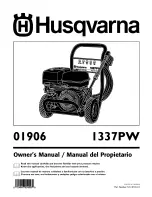
Leakage between the cover and body is usually caused by shrinkage of the sealing ring after prolonged use. Replace the seal-
ing ring. Whenever you replace the sealing ring, replace the overpressure plug also.
11. The formation of a small amount of moisture under the pressure regulator is normal when cooking first begins. It is the result
of the temperature of the regulator being lower than the rest of the unit.
A small amount of steam or moisture may also be visible around the overpressure plug and air vent/cover lock as cooking
begins. It should stop when pressure begins to build and the overpressure plug and air vent/cover lock seal. If leakage contin-
ues, clean or replace the overpressure plug and/or air vent/cover lock gasket. The pressure cooker will not seal if the gasket
for the air vent/cover lock is cracked.
Do not operate your pressure cooker with continual leakage
If the preceding steps do not correct the problem, return the
entire unit to the presto Factory Service Department (see page 43).
12. If the pressure cooker becomes difficult to open or close, the sealing ring may have expanded and should be replaced.
If for any reason the pressure cooker cannot be opened, contact the Consumer Service Department in Eau Claire, WI at
1-800-877-0441.
Any maintenance required for this product, other than normal household care and cleaning, should be performed by the presto
Factory Service Department (see page 43).
8
HelPful HiNTS
your favorite recipes may be adjusted for cooking in the pressure cooker by following the general directions in this book for
the particular type of food being cooked. Decrease the cooking time for your recipe by
2
⁄
3
since pressure cooking is much faster
than ordinary cooking methods. For example, if your ordinary cooking method requires 45 minutes, in the pressure cooker
the cooking time will be 15 minutes. Because there is very little evaporation, the amount of liquid used should be decreased.
Use about 1 cup more liquid than you’ll desire in your finished dish. But, remember, there must always be water or some other
liquid in the pressure cooker to produce the necessary steam.
Use the trivet and steamer basket when it is desirable to cook foods out of the cooking liquid. When foods are pressure cooked
out of the liquid, flavors will not intermingle. Therefore, it is possible to cook several foods at once, as long as they have similar
cooking times.
Many different cooking liquids can be used in a pressure cooker. Wine, beer, bouillon, fruit juices, and of course water all make
excellent cooking liquids in the pressure cooker.
If a recipe says to cook 0 minutes, release pressure immediately after pressure cooker reaches cooking pressure.
Release pressure quickly after cooking delicate foods such as custards, fresh vegetables, and serving size pieces of meat. For
other foods, like roasts and stews, let the pressure drop of its own accord.
Beautiful desserts and side dishes can be prepared in the pressure cooker using individual or small metal molds or glass custard
cups, which are ovenproof. Fill molds
2
⁄
3
full to allow for expansion of food, and fit them loosely into the pressure cooker in
the steamer basket. Do not fill the pressure cooker over
2
⁄
3
full.
When pressure cooking at high altitudes, the cooking time needs to be increased 5% for every 1000 feet above the first 2000
feet. Following this rule, the times should be increased as follows:
3000 ft. . . . . . . . 5%
5000 ft. . . . . . . . . . . 15%
7000 ft. . . . . . . . . . . 25%
4000 ft. . . . . . . . 10%
6000 ft. . . . . . . . . . . 20%
8000 ft. . . . . . . . . . . 30%
Because pressure cooking times are increased at altitudes above 2000 feet, an additional 1 cup cooking liquid will be
needed.
If you have any questions on recipes, time charts, or the operation of your pressure cooker, call or write: Test
Kitchen, national presto Industries, Inc., 3925 north Hastings Way, Eau Claire, Wisconsin 54703-3703, phone
1-800-368-2194 (e-mail: [email protected]). When writing, please include a phone number and a time when you can be
reached during weekdays, if possible. Written inquiries will be answered promptly by letter or telephone.









































